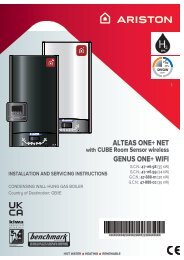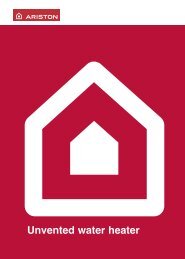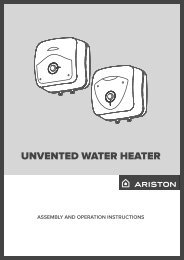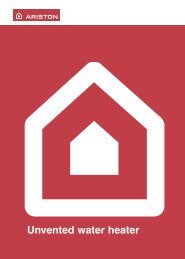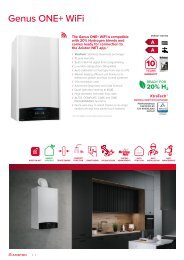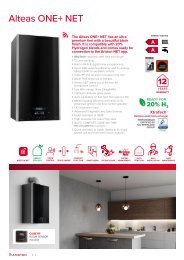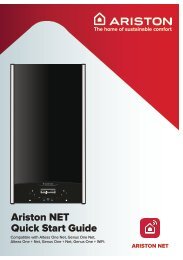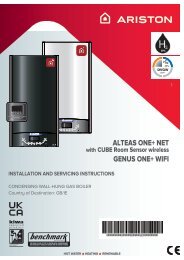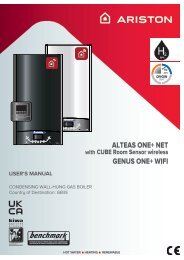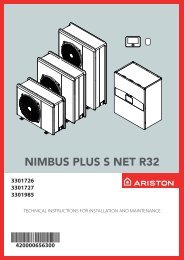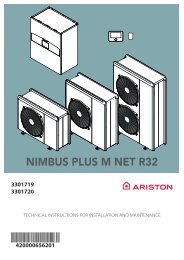Nimbus Compact M NET R32 Installation Manual UK
You also want an ePaper? Increase the reach of your titles
YUMPU automatically turns print PDFs into web optimized ePapers that Google loves.
a<br />
a<br />
a<br />
a<br />
a<br />
a<br />
a<br />
a<br />
a<br />
a<br />
Replacement parts shall be in accordance with<br />
the manufacturer’s specifications.<br />
The check must also take into account the effects<br />
of ageing or the continuous vibrations generated<br />
by sources such as compressors or fans.<br />
It is possible to use electronic leak detectors to<br />
find refrigerant leakages, but if flammable refrigerants<br />
are used their sensitivity may be inadequate<br />
or may have to be recalibrated.<br />
Fluids for detecting leaks are also suitable for<br />
use with most refrigerants, however detergents<br />
containing chlorine must be avoided, as chlorine<br />
may react with the refrigerant and corrode the<br />
copper pipes.<br />
If a leak is suspected, all ignition sources must be<br />
removed/extinguished.<br />
Do not apply any permanent inductive or capacitance<br />
loads to the circuit without ensuring that<br />
this will not exceed the permissible voltage and<br />
current permitted for the equipment in use.<br />
Intrinsically safe components are the only types<br />
that can be worked on while live in the presence<br />
of a flammable atmosphere. The test apparatus<br />
shall be at the correct rating.<br />
Replace components only with parts specified by<br />
the manufacturer. Other parts may result in the<br />
ignition of refrigerant in the atmosphere from a<br />
leak.<br />
Check that cabling will not be subject to wear,<br />
corrosion, excessive pressure, vibration, sharp<br />
edges or any other adverse environmental effects.<br />
However, for flammable refrigerants it is important<br />
that best practice is followed since flammability<br />
is a consideration.<br />
The following procedure must be observed:<br />
– Remove the refrigerant.<br />
– Purge the circuit with inert gas.<br />
– Flush the system.<br />
– Purge with inert gas.<br />
– Open the circuit through cutting or brazing.<br />
a<br />
a<br />
a<br />
a<br />
a<br />
a<br />
a<br />
a<br />
a<br />
Service<br />
If repairs (or any other intervention) must be carried<br />
out in the refrigerant circuit, conventional<br />
procedures must be used.<br />
When the final oxygen-free nitrogen charge is<br />
used, the system shall be vented down to atmospheric<br />
pressure to enable work to take place.<br />
Ensure that the outlet for the vacuum pump is<br />
not close to any potential ignition sources and<br />
that ventilation is available.<br />
Cylinders shall be kept in an appropriate position<br />
according to the instructions.<br />
Ensure that the refrigerating system is earthed<br />
prior to charging the system with refrigerant.<br />
Extreme care shall be taken not to overfill the refrigerating<br />
system.<br />
Prior to recharging the system, it shall be pressure-tested<br />
with the appropriate purging gas.<br />
The system shall be leak-tested on completion<br />
of charging but prior to commissioning. A follow<br />
up leak test shall be carried out prior to leaving<br />
the site.<br />
It is recommended good practice that all refrigerants<br />
are recovered safely. Prior to the task<br />
being carried out, an oil and refrigerant sample<br />
shall be taken in case analysis is required prior<br />
to re-use of recovered refrigerant. It is essential<br />
that electrical power is available before the task<br />
is commenced.<br />
EN / 71







